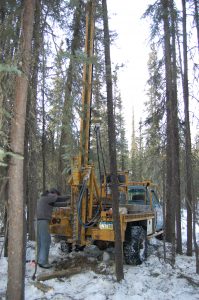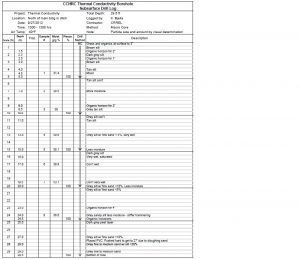Steps to Building on Permafrost
Site Evaluation
The first step in a region with permafrost is to determine whether it exists at the site. Visual clues can provide hints as to whether permafrost exists on site.
Vegetation
The vegetated landscape can provide a good indication on the existence of permafrost on the site. Boreal trees (e.g.: black spruce, Picea mariana) are a reliable indicator that there is permafrost below the surface. Black spruce proliferates in cold, poorly drained soils. The high moisture content of the soil is indicative of thaw unstable permafrost conditions. Conversely, deciduous forests (e.g.: white spruce, Picea glauca) should not always be relied on to indicate the presence of permafrost. The permafrost layer depth could be low enough to allow a birch forest root network to exist. Vegetation type should not be considered a guarantee on the presence of permafrost.
photo of thick moss
Orientation/Elevation
The predominant orientation of a site can determine whether appropriate conditions exist for stable permafrost. South-facing sites receive more sunlight over the course of the year, and are less likely to have frozen permafrost beneath the surface. Inversely, north-facing sites receive less sunlight and are more likely to have permafrost. In flat, low-lying areas, permafrost can prevent the percolation of water, leading to swampy, boggy conditions. Higher altitude, sloped land is less conducive to permafrost because the water can drain from the site when ground temperatures reach appropriate conditions.
Site Testing
Visual examination of a site is not enough to determine permafrost conditions. The depth, soil conditions, and spatial permeation of permafrost can only be ascertained through looking at the subsu rface. Testing can be performed via borehole drilling (hollow core or standard auger), ground penetrating radar (GPR), electrical resistivity tomography (ERT), or test pits at a specific site.
rface. Testing can be performed via borehole drilling (hollow core or standard auger), ground penetrating radar (GPR), electrical resistivity tomography (ERT), or test pits at a specific site.
Consult an engineer

Contact a civil or structural engineer experienced in performing geotechnical exploration in cold climates. Generally, this will entail investigatory research, a physical site visit, site sampling, and a written report. Reports should detail borehole locations, method of temperature measurement, soil classification, soil composition, soil moisture content, permafrost presence, and permafrost thickness (if present). This is not a conclusive list and reports may differ depending on the contractor.
How to make this photo clickable? It has a useful caption. Maybe all photos should
References
Black spruce: https://www.for.gov.bc.ca/hfd/library/documents/treebook/blackspruce.htm
White Spruce: http://www.fs.fed.us/database/feis/plants/shrub/betgla/all.html
http://permafrost.gi.alaska.edu/sites/default/files/TSP_manual.pdf